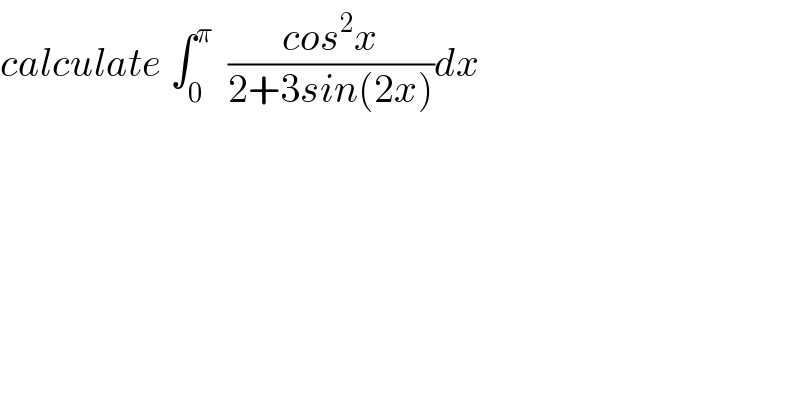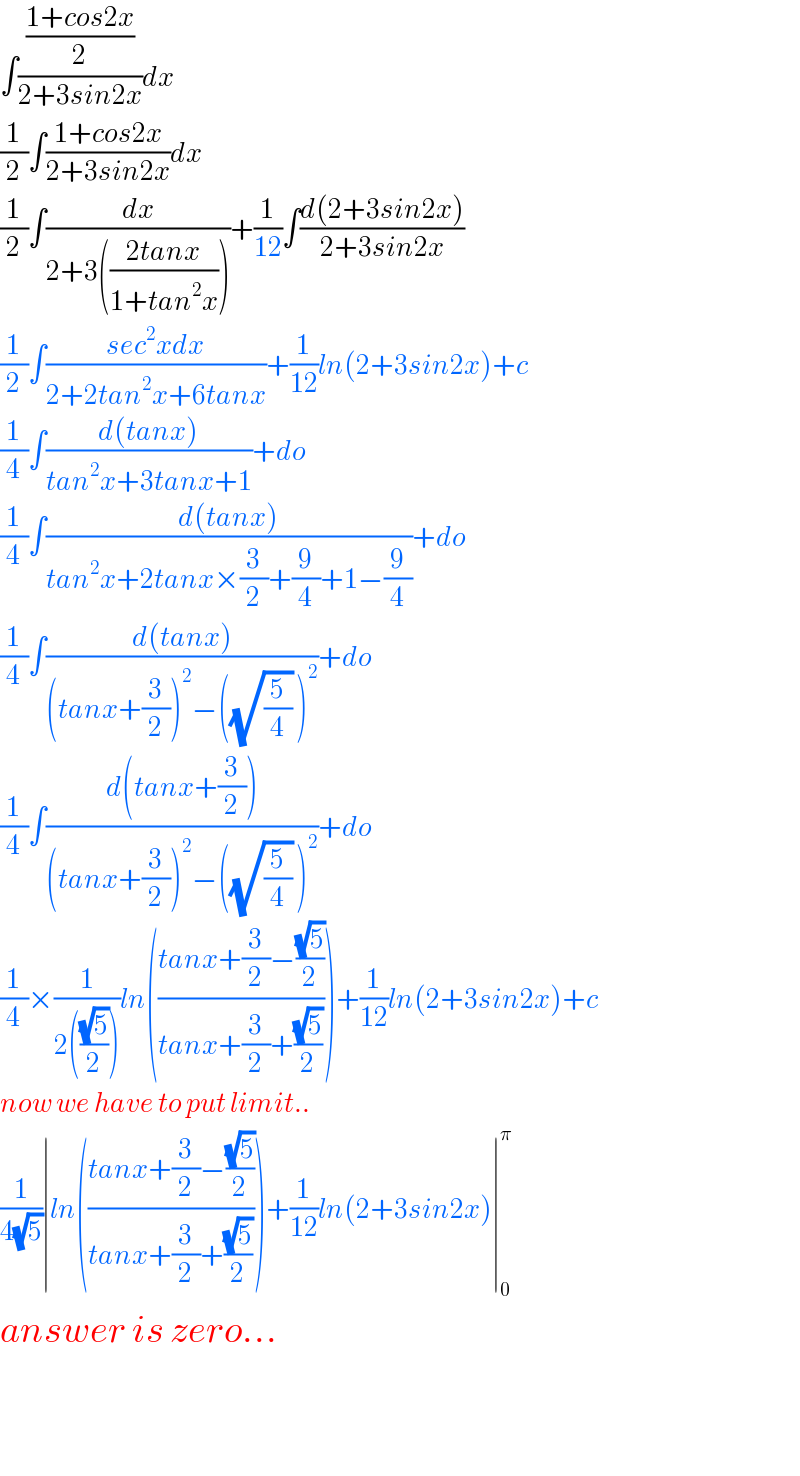
Question Number 53080 by Abdo msup. last updated on 17/Jan/19

$${calculate}\:\int_{\mathrm{0}} ^{\pi} \:\:\frac{{cos}^{\mathrm{2}} {x}}{\mathrm{2}+\mathrm{3}{sin}\left(\mathrm{2}{x}\right)}{dx} \\ $$
Commented by maxmathsup by imad last updated on 17/Jan/19

$${let}\:{A}\:=\int_{\mathrm{0}} ^{\pi} \:\:\frac{{cos}^{\mathrm{2}} {x}}{\mathrm{2}+\mathrm{3}{sin}\left(\mathrm{2}{x}\right)}{dx}\:\Rightarrow{A}=\int_{\mathrm{0}} ^{\pi} \:\:\frac{\mathrm{1}+{cos}\left(\mathrm{2}{x}\right)}{\mathrm{2}\left(\mathrm{2}+\mathrm{3}{sin}\left(\mathrm{2}{x}\right)\right)}{dx} \\ $$$$=_{\mathrm{2}{x}={t}} \:\int_{\mathrm{0}} ^{\mathrm{2}\pi} \:\:\frac{\mathrm{1}+{cos}\left({t}\right)}{\mathrm{2}\left(\mathrm{2}+\mathrm{3}{sin}\left({t}\right)\right)}\:\frac{{dt}}{\mathrm{2}}\:=\frac{\mathrm{1}}{\mathrm{4}}\:\int_{\mathrm{0}} ^{\mathrm{2}\pi} \:\:\:\frac{\mathrm{1}+{cos}\left({t}\right)}{\mathrm{2}+\mathrm{3}{sin}\left({t}\right)}{dt}\:\Rightarrow \\ $$$$\mathrm{4}{A}\:=\int_{\mathrm{0}} ^{\mathrm{2}\pi} \:\:\:\frac{\mathrm{1}+{cost}}{\mathrm{2}+\mathrm{3}{sint}}\:{dt}\:\:=\:{Re}\left(\:\int_{\mathrm{0}} ^{\mathrm{2}\pi} \:\:\frac{\mathrm{1}+{e}^{{it}} }{\mathrm{2}+\mathrm{3}{sint}}{dt}\right)\:{let}\:\:{changement}\:{e}^{{it}} ={z}\:{give} \\ $$$$\int_{\mathrm{0}} ^{\mathrm{2}\pi} \:\:\frac{\mathrm{1}+{e}^{{it}} }{\mathrm{2}+\mathrm{3}{sint}}{dt}\:=\int_{\mid{z}\mid=\mathrm{1}} \:\:\frac{\mathrm{1}+{z}}{\mathrm{2}+\mathrm{3}\frac{{z}−{z}^{−\mathrm{1}} }{\mathrm{2}{i}}}\frac{{dz}}{{iz}}\:=\:\int_{\mid{z}\mid=\mathrm{1}} \:\:\:\frac{\mathrm{2}{i}\left(\mathrm{1}+{z}\right)}{{iz}\left(\mathrm{4}{i}\:+\mathrm{3}{z}−\mathrm{3}{z}^{−\mathrm{1}} \right)}{dz} \\ $$$$=\int_{\mid{z}\mid=\mathrm{1}} \:\:\:\frac{\mathrm{2}\left(\mathrm{1}+{z}\right)}{\mathrm{4}{iz}\:+\mathrm{3}{z}^{\mathrm{2}} \:−\mathrm{3}}{dz}\:\:{let}\:{consider}\:{the}\:{complex}\:{function}\: \\ $$$$\varphi\left({z}\right)=\frac{\mathrm{2}\left(\mathrm{1}+{z}\right)}{\mathrm{3}{z}^{\mathrm{2}} \:+\mathrm{4}{iz}\:−\mathrm{3}}\:\:{poles}\:{of}\:\varphi?\:\:{let}\:{find}\:{roots}\:{of}\:\mathrm{3}{z}^{\mathrm{2}} \:+\mathrm{4}{iz}\:−\mathrm{3} \\ $$$$\Delta^{'} =\left(\mathrm{2}{i}\right)^{\mathrm{2}} −\mathrm{3}\left(−\mathrm{3}\right)\:=−\mathrm{4}+\mathrm{9}\:=\mathrm{5}\:\Rightarrow{z}_{\mathrm{1}} =\frac{−\mathrm{2}{i}+\sqrt{\mathrm{5}}}{\mathrm{3}}\:\:{and}\:{z}_{\mathrm{2}} =\frac{−\mathrm{2}{i}−\sqrt{\mathrm{5}}}{\mathrm{3}}\left({are}\:{poles}\:{of}\:\varphi\right) \\ $$$$\mid{z}_{\mathrm{1}} \mid−\mathrm{1}\:=\frac{\mathrm{1}}{\mathrm{3}}\sqrt{\mathrm{4}+\mathrm{5}}=\mathrm{3}\:>\mathrm{0}\:\Rightarrow{z}_{\mathrm{1}} \:{is}\:{out}\:{of}\:{circle}\:\Rightarrow{Res}\left(\varphi,{z}_{\mathrm{1}} \right)=\mathrm{0} \\ $$$$\mid{z}_{\mathrm{2}} \mid−\mathrm{1}\:=\frac{\mathrm{1}}{\mathrm{3}}\sqrt{\mathrm{4}+\mathrm{5}}=\mathrm{3}>\mathrm{0}\:\Rightarrow{z}_{\mathrm{2}} {is}\:{out}\:{of}\:{circle}\:\Rightarrow{Res}\left(\varphi,{z}_{\mathrm{2}} \right)=\mathrm{0}\: \\ $$$$\int_{\mid{z}\mid=\mathrm{1}} \varphi\left({z}\right){dz}\:=\mathrm{2}{i}\pi\left\{\:{Res}\left(\varphi,{z}_{\mathrm{1}} \right)\:+{Res}\left(\varphi,{z}_{\mathrm{2}} \right)\right\}=\mathrm{0}\:\Rightarrow{Re}\left(\int\:\varphi\left({zdz}\right)=\mathrm{0}\:\Rightarrow\right. \\ $$$${A}\:=\mathrm{0}\:. \\ $$
Answered by tanmay.chaudhury50@gmail.com last updated on 17/Jan/19

$$\int\frac{\frac{\mathrm{1}+{cos}\mathrm{2}{x}}{\mathrm{2}}}{\mathrm{2}+\mathrm{3}{sin}\mathrm{2}{x}}{dx} \\ $$$$\frac{\mathrm{1}}{\mathrm{2}}\int\frac{\mathrm{1}+{cos}\mathrm{2}{x}}{\mathrm{2}+\mathrm{3}{sin}\mathrm{2}{x}}{dx} \\ $$$$\frac{\mathrm{1}}{\mathrm{2}}\int\frac{{dx}}{\mathrm{2}+\mathrm{3}\left(\frac{\mathrm{2}{tanx}}{\mathrm{1}+{tan}^{\mathrm{2}} {x}}\right)}+\frac{\mathrm{1}}{\mathrm{12}}\int\frac{{d}\left(\mathrm{2}+\mathrm{3}{sin}\mathrm{2}{x}\right)}{\mathrm{2}+\mathrm{3}{sin}\mathrm{2}{x}} \\ $$$$\frac{\mathrm{1}}{\mathrm{2}}\int\frac{{sec}^{\mathrm{2}} {xdx}}{\mathrm{2}+\mathrm{2}{tan}^{\mathrm{2}} {x}+\mathrm{6}{tanx}}+\frac{\mathrm{1}}{\mathrm{12}}{ln}\left(\mathrm{2}+\mathrm{3}{sin}\mathrm{2}{x}\right)+{c} \\ $$$$\frac{\mathrm{1}}{\mathrm{4}}\int\frac{{d}\left({tanx}\right)}{{tan}^{\mathrm{2}} {x}+\mathrm{3}{tanx}+\mathrm{1}}+{do} \\ $$$$\frac{\mathrm{1}}{\mathrm{4}}\int\frac{{d}\left({tanx}\right)}{{tan}^{\mathrm{2}} {x}+\mathrm{2}{tanx}×\frac{\mathrm{3}}{\mathrm{2}}+\frac{\mathrm{9}}{\mathrm{4}}+\mathrm{1}−\frac{\mathrm{9}}{\mathrm{4}}}+{do} \\ $$$$\frac{\mathrm{1}}{\mathrm{4}}\int\frac{{d}\left({tanx}\right)}{\left({tanx}+\frac{\mathrm{3}}{\mathrm{2}}\right)^{\mathrm{2}} −\left(\sqrt{\frac{\mathrm{5}}{\mathrm{4}}}\:\right)^{\mathrm{2}} }+{do} \\ $$$$\frac{\mathrm{1}}{\mathrm{4}}\int\frac{{d}\left({tanx}+\frac{\mathrm{3}}{\mathrm{2}}\right)}{\left({tanx}+\frac{\mathrm{3}}{\mathrm{2}}\right)^{\mathrm{2}} −\left(\sqrt{\frac{\mathrm{5}}{\mathrm{4}}}\:\right)^{\mathrm{2}} }+{do} \\ $$$$\frac{\mathrm{1}}{\mathrm{4}}×\frac{\mathrm{1}}{\mathrm{2}\left(\frac{\sqrt{\mathrm{5}}}{\mathrm{2}}\right)}{ln}\left(\frac{{tanx}+\frac{\mathrm{3}}{\mathrm{2}}−\frac{\sqrt{\mathrm{5}}}{\mathrm{2}}}{{tanx}+\frac{\mathrm{3}}{\mathrm{2}}+\frac{\sqrt{\mathrm{5}}}{\mathrm{2}}}\right)+\frac{\mathrm{1}}{\mathrm{12}}{ln}\left(\mathrm{2}+\mathrm{3}{sin}\mathrm{2}{x}\right)+{c} \\ $$$${now}\:{we}\:{have}\:{to}\:{put}\:{limit}.. \\ $$$$\frac{\mathrm{1}}{\mathrm{4}\sqrt{\mathrm{5}}}\mid{ln}\left(\frac{{tanx}+\frac{\mathrm{3}}{\mathrm{2}}−\frac{\sqrt{\mathrm{5}}}{\mathrm{2}}}{{tanx}+\frac{\mathrm{3}}{\mathrm{2}}+\frac{\sqrt{\mathrm{5}}}{\mathrm{2}}}\right)+\frac{\mathrm{1}}{\mathrm{12}}{ln}\left(\mathrm{2}+\mathrm{3}{sin}\mathrm{2}{x}\right)\mid_{\mathrm{0}} ^{\pi} \\ $$$${answer}\:{is}\:{zero}... \\ $$$$ \\ $$$$ \\ $$
